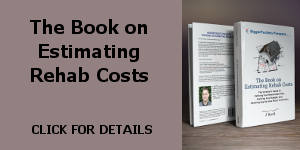My last post kicked off the discussion about the various strategies that I plan to use for my investing. I included the first half of the “Investment Strategy” section of my Business Plan, which covered “Fundamental Investments.”
Below I continue with that section of my Business Plan, adding detail about the other type of investing strategy I plan to pursue — “Value Play Investments”. I talked a good bit about the Value Play in a previous post, and this part of my strategy reiterates many of those ideas.
LISH PROPERTIES BUSINESS PLAN
Short-Term “Value Play†Investments
When available, the company will make “value play†investments to generate short-term (1-5 years) capital gains. The key to the value play will be purchasing mismanaged properties in temporarily depressed areas at well below current market rates; the goal will be to add short-term value and resell for large capital gains. These types of transactions will provide the working capital needed to acquire additional longer-term “fundamental†investments.
These opportunities will generally result from the convergence of the following circumstances:
- Poor real estate performance in a localized area due to temporary economic conditions leading to population or job losses. In order to qualify as a “value play,†indicators should point towards a reversal in population decline (i.e., population increase), reversal in job decline (i.e., job increase), and/or a strengthening of the local economic framework (e.g., increased salaries, etc);
- Poor management by the current owners – often brought about by the negative economic indicators above – that result in high-vacancies, below-market rents, or high recurring expenses;
- The existence of short-term property improvement that can be carried out to quickly increase the value of the overall property. These types of improvement include – but are not limited to – the following:
- High Vacancy Due to Poor Management
- Below Market Rents
- Extensive Cosmetic (not Structural) Repairs
- Master-Metered Properties that can be Converted to Sub-Metered
- Ability to Add Income Producing Services (Laundry, Vending Machines, etc)
- Ability to Protest High Tax Assessments
By focusing on rectifying the underlying issues that have contributed to the poor performance of the property, by making short-term property improvements, and by leveraging the improving localized economic trends, there will exist a great opportunity to acquire and quickly increase the total market value of the under-performing property.
When evaluating a property as a short-term value play, the entry and exit strategies for the property will be carefully considered. Properties without substantial upside potential from these added values will not be considered for purchase unless they also meet (prior to purchase) the minimum financial criteria defined for long-term “fundamental†investments.
[googmonify]9523523149:center:468:60[/googmonify]




Are you planning to invest only in the Atlanta area?
Point 1 makes me believe that you will have to invest nationally to be able to identify areas, study the market conditions and understand the areas, and then buy and manage a property in that area. Staying local reduces significantly your market.
I do recognize that staying local will give you a better understanding of the submarkets, but I wonder if that would limit your options, as you would depend on the general economic conditions of your area.
Andres,
Definitely agree with everything you wrote…
The goal is certainly to start locally. This is one of the reasons we chose to move to Atlanta…after spending some time analyzing the market (which I’ll discuss in a later post), it was clear that there is upside here in at least some types of RE investing (and apartments have looked attractive here, specifically).
Once I feel like I understand the business, and I trust my ability to analyze deals and put proper management into place, then I’ll definitely consider branching out to other areas.
Additionally, in the short-term I’d definitely consider partnering up with people in different areas to put together deals; as long as I know there are partners locally.
I want to thank you. By looking at your plan, I realized how grossly undeveloped my plan is. This is a great guideline to get started from.
Thanks Bilge. That’s very kind, and I’m thrilled that this was able to help!